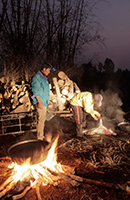
Stories from Northeastern Thailand

1
Kongkoy and Kampha

2
Ao Ja Klawa Naa Ja Kreng

3
An orphan and vultures

4
Khun Tung Khun Taeung

5
Granpa Sorn

6
Ja Ann and Nang Sansri

7
Tang Chang Phuek, or Pu Sangkasa Ya Sangkasri

8
Pathom-Jomjok

9
Ban Ta Yiam

10
Tuk Hai Liang Pla Kiang Hai Lai Nee

11
Kampa Phinoy

12
Padang Nang Ai

13
Rhino Head Pond

14
Rhino Head Pond 2

15
The Efficacy of Fear – Forest Spirits
The northeastern region of Thailand is more popularly known as Isan. Isan originates from a Sanskrit word meaning “north east direction.” The word began to be used extensively at the beginning of the 20th century to refer to the entire region. Isan is Thailand's largest region and is located on the Khorat Plateau. It also borders the Mekong River. A number of important rivers, including the Songkhram and Mun, both major Mekong tributaries, and the Chi River, a Mun tributary, run through Isan.
Isan is home to several Mon-Khmer languages of the Austroasiatic family. The first story below was told in Thai So, which is a language belonging to the Katuic branch of Mon-Khmer languages. People who speak So live on both sides of the Mekong River, with about 118,000 on the Lao side and 70,000 on the Thailand side, especially in Nakhon Phanom and Sakon Nakhon Provinces. The language is still actively used. Thai So orthography has also been developed based on Thai scripts and is used among speakers of the language (Lewis et al. 2015).
Isan is also home to some Tai-Kadai languages. The most notable Tai-Kadai language in Isan is Northeastern Thai, also known and spelled as Esarn, Isan, Isaan and so forth. It is a language of regional identity among Isan speakers and is used habitually in every domain of life in the region, including at home. The language is written in Thai script. The total population of Isan speakers is estimated to be around 15,000,000. At least 1,000,000 live in Bangkok (Lewis et al. 2015).
Isan is home to several Mon-Khmer languages of the Austroasiatic family. The first story below was told in Thai So, which is a language belonging to the Katuic branch of Mon-Khmer languages. People who speak So live on both sides of the Mekong River, with about 118,000 on the Lao side and 70,000 on the Thailand side, especially in Nakhon Phanom and Sakon Nakhon Provinces. The language is still actively used. Thai So orthography has also been developed based on Thai scripts and is used among speakers of the language (Lewis et al. 2015).
Isan is also home to some Tai-Kadai languages. The most notable Tai-Kadai language in Isan is Northeastern Thai, also known and spelled as Esarn, Isan, Isaan and so forth. It is a language of regional identity among Isan speakers and is used habitually in every domain of life in the region, including at home. The language is written in Thai script. The total population of Isan speakers is estimated to be around 15,000,000. At least 1,000,000 live in Bangkok (Lewis et al. 2015).
